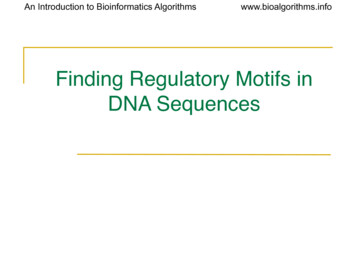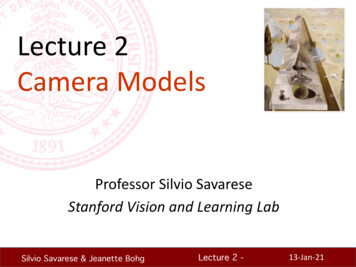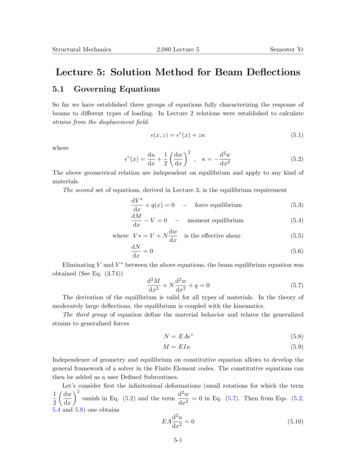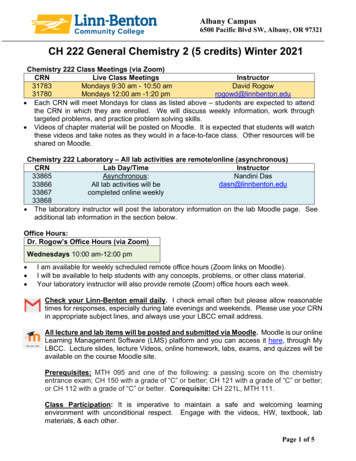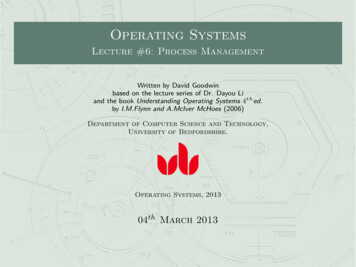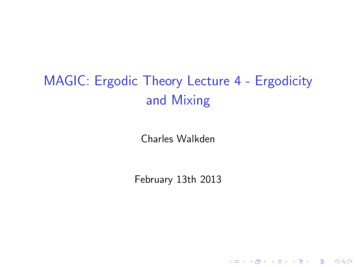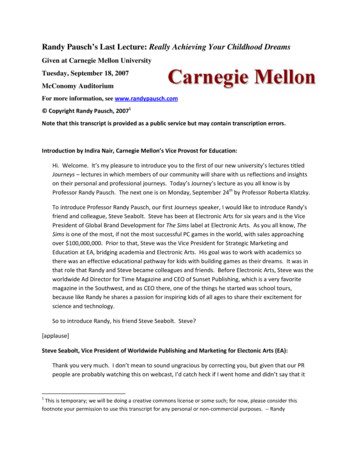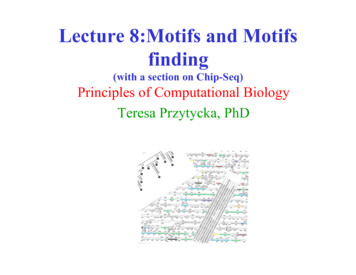
Transcription
Lecture 8:Motifs and Motifsfinding(with a section on Chip-Seq)Principles of Computational BiologyTeresa Przytycka, PhD
Motifs Motif is a region (a subsequence) of proteinor DNA sequence that has a specificstructure Motifs are candidates for functionallyimportant sites Presence of a motif may be used as a baseof protein classification
Representation of motifs Profile or sequence logos Regular expression
Describing patterns using regularexpressionsAstartBBDAendCA graph like one above is called in CS literature a finite automaton canbe used do describe a sequence family (CS literature such a set ofsequences is called a language):Take any path from “start” to “end” and as you go print the letters thatlabel the edges you used. Any sequence that can be printed in this waywill be called generated (CS term: accepted) by the automaton.E.g.: ABCCCCD; BACCD; .
Regular expressionsAstartBBDAendCA finite automaton can be translated to so called regular expressions:Notation:[choice1, choice2, .] a set of choices in a brunching point ,- “followed by”* repeat 0 or more timesE.g. The regular expression describing automaton above:[A-B , B-A]-C*-D
PROSITE A data base of regular expression that describeprotein motifs Developed since 1988 1999 – authors recognize that some proteinfamilies are characterized by profiles than regularexpression and extended the data base to containprofiles Profiles are generated from multiple sequencealignments
PROSITE patterns PROSITE fingerprints are described by regular expressions Rules:– Each position is separated by a hyphen– One character denotes residuum at a given position– [ ] denoted a set of allowed amino acids– (n) denotes repeat of n times– (n,m) denoted repeat between n and m inclusive– X – any characterExample [EDQH]-x-K-x-[DN]-G-x-R-[GACV]Ex. ATP/GTP binding motive [SG]-X(4)-G-K-[DT] There is a number of programs that allow to search databasesfor PROSITE patterns
Finding motifs Method I: extracted from multiple sequencealignment .– EMOTIF– PRINTS Method II: Gibbs sampling – a method that allowsto find motifs in the absence of multiple sequencealignmentReference: Lawrence,.C.E. et al (1993) Science263, 208-214 Method III: Exhaustive or dedicated search
Recognition of transcription factorbinding sites Transcription Factors proteins that bind DNA,typically upstream or close to the transcriptionstart site and regulate the expression of the geneby activating or inhibiting the transcriptionmachinery Little is know about most of transcription factors itparticular what binding sites most of them are. Co-regulated genes – genes to which are regulatedby the same transcription factor
Typical setting for computationalfinding of transcription binding sites Give is collection of regulatory regions ofgenes that are believed to be co-regulated. Goal – fund sort DNA motifs that areoverrepresented. So what is the problem?– Binding motifs are typically short– They have significant variability There is a large number of other algorithms:(AlignACE, MEME, Weeder, YMF )
Examples of binding sites profiles
Finding Motifs with Gibbs SamplingMethod Assumption: Given is a set of sequences thatare believed to share (one) common motif Motif is assumed to have length wwIdea: Look for a signal using a Monte Carlo method
Initialization: Make a guess Choose randomly at each sequence a candidateposition for the motifa2a1a3a4Our guesses (all missed)our windowa1a3a2a4
The basic algorithm Initialization: Choose randomly at eachsequence a candidate position for the motif Iterate the following two steps untilconvergence:– Predictive update: detecting current signal fromthe motif identified so far– Sampling: improving the signal
Predictive update step –leave one out One of N sequences, say z, is removed(randomly or in specific order) The pattern frequencies (position specificscoring matrix) and backgroundprobabilities are computed with z excluded
Two evolving data structuresmaintained by the algorithm Pattern description in the form ofprobabilistic model of residue frequencies– qi1, qi20; i 1, w (qik is the frequency ofamino-acid k on position i of the pattern)– p1, p20 ; background frequency Local alignment description– a1, aN; N-number of sequences;– ai – beginning of the pattern in the ith sequence
Sampling Step Every possible sequence x of length w is aligned withthe profile in the window Calculate probability Qx of generating x according toprobability distribution defined by current patterndescription (profile) (qi1, qi20 ; i 1.w)– e.g, probability of ATCA q1A q2T q3C q4A Calculate probability Px of generating x according tobackground probability distribution p1, p20 Assign weight Ax Qx / Px to the sequence x Choose with probability weighted by Ax the sequence xto be aligned with current patter
Sampling Stepa3a2a4zi Try all possible alignments of z to the profiledefined by the pattern we found so far. Each position i has some probability pi of beinggood (if no pattern all position should beequally likely) Chose fragment from i to i w to be be alignedto the window with probability pi.We know theProfile of this alignment(still no pattern found sothis profile shouldcorrespond to randoma.a. distribution)
Why it is supposed to worka3a2Eventually a piece of motif gets into the window. This increases theprobability of getting matching motif form the next left out sequence
Note that this one has agood chance to fit thepattern in the window
Finally after a number of iteration we have a good chance toarrive to the following configuration:Now we are in a local maximum, when we leave one sequence out andput it back out it has a high probability to realign where it was.When no further improvement is observed we assume that have apattern or a part of it in the window and we try to move the windowslightly to the sides to discover the rest of the motif
High throughput sequencing technologies(next generation sequencing)DNA moleculesare physicallybound to asurface, andsequenced ds/2009/09/next-gen-seq-fig-1.jpg
How this facilitates identification of bindingmotifs3’5’TFSequence DNA fragmentsMapping ofsequenced tags tothe genomeSearch for motifs inpredicted regions ((with modifications)ApproximateTF positionReference genomePredictedposition 1Predictedposition 2 Predictedposition n
Aligning short readsChallenge – alignment a large number of short reads(hundreds of billions of bases total)Programs:-SOAP, Maq, Bowtie, RMAP, ZOOM, SHRiMP, ElandEach tool builds a hash table of short oligomers present in eitherthe reads (SHRiMP, Maq, RMAP, and ZOOM) or the reference(SOAP).Eland - a commercial alignment program from Illumina
Bowtie:Ben Langmead, Cole Trapnell, Mihai Pop and Steven L Salzberg
Burrows-Wheeler indexing originally developed within the context of data compression allows large texts to be searched efficiently in a small memoryfootprint.
The character is appended to T,where is not in T and is lexicographically less thanall characters in T.The Burrows-Wheeler matrix of T is constructed as the matrix whose rows comprise allcyclic rotations of T .The rows are then sorted lexicographically. BWT(T) is the sequence of characters inthe rightmost column of the Burrows-Wheeler matrixBWT(T) has the same length as the original text T.TW(T)
This matrix has a property called 'last first (LF) mappingThe ith occurrence of character X in the last column corresponds to the same textcharacter as the ith occurrence of X in the first.
This matrix has a property called 'last first (LF) mappingThe ith occurrence of character X in the last column corresponds to the same textcharacter as the ith occurrence of X in the first.UNPERMUTE repeatedly applies the last first (LF) mapping to recover the originaltext (in red on the top line) from the Burrows-Wheeler transform (in black in therightmost column). in the rightmost column).
EXACTMATCH algorithm calculates the range of matrix rows beginning withsuccessively longer suffixes of the query.Because the matrix is sorted lexicographically, rows beginning with agiven sequence appear consecutively.At each step of EXACTMATCH, the size of the range either shrinks orremains the same. When the algorithm completes, rows beginning with S0 (theentire query) correspond to exact occurrences of the query in the text.If the range is empty, the text does not contain the query.Below steps taken by EXACTMATCH to identify the range of rows, and thus theset of reference suffixes, prefixed by 'aac'no extension
Each character in a read has a numeric quality value, with lowervalues indicating a higher likelihood of a sequencing error.Bowtie alignment policy allows a limited number of mismatchesand prefers (no guarantees) alignments where the sum of thequality values at all mismatched positions is low.
There is no exact matchfor query 'ggta' but there isa one-mismatch alignmentwhen 'a' is replaced by 'g'.Boxed pairs of numbersdenote ranges of matrixrows beginning with thesuffix observed up to thatpoint. A red X markswhere the algorithmencounters an empty rangeand either aborts (as inEXACTMATCH) orbacktracks (as in theinexact algorithm). Agreen check marks wherethe algorithm finds anonempty range delimitingone or more occurrencesof a reportable alignmentfor the query.
Tricks and heuristicsIf only one error is allowed once can build second index foralignment in the reverse direction and such two error freealignments would “meet” at the position of the errorThe is there is error-free prefix error error-free postfixThis doesn’t work for more than one error and Bowties findsthe best solution it can do in the k 200 steps (a parameter ofthe alignment, estimated experimentally ) and gives up.
Index building Kärkkäinen J: Fast BWT in small space byblockwise suffix sorting. Theor Comput Sci2007, 387:249-257.
Other algorithms that use BW transform Li H, Durbin R (2009). "Fast and accurate short readalignment with Burrows–Wheeler Transform".Bioinformatics. PMID 19451168. Li R, et al (2009). "SOAP2: an improved ultrafast tool forshort read alignment". Bioinformatics. PMID 19497933.
RNA-Seq provides means to measure transcriptome data experimentally,Applications:-Measuring mRNA level- Uncovering intron-exon genestructure-Detecting transcribed isoformsRNA-Seq: a revolutionary tool for transcriptomicsZhong Wang, Mark Gerstein & Michael Snyder; Jan 2009
Lecture 8:Motifs and Motifs finding (with a section on Chip-Seq)


